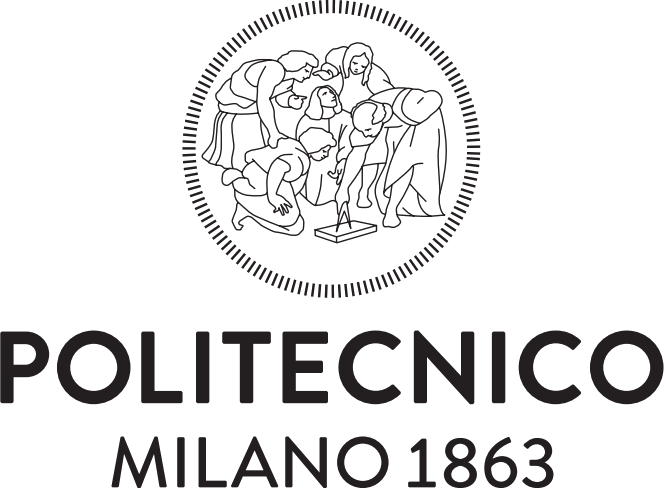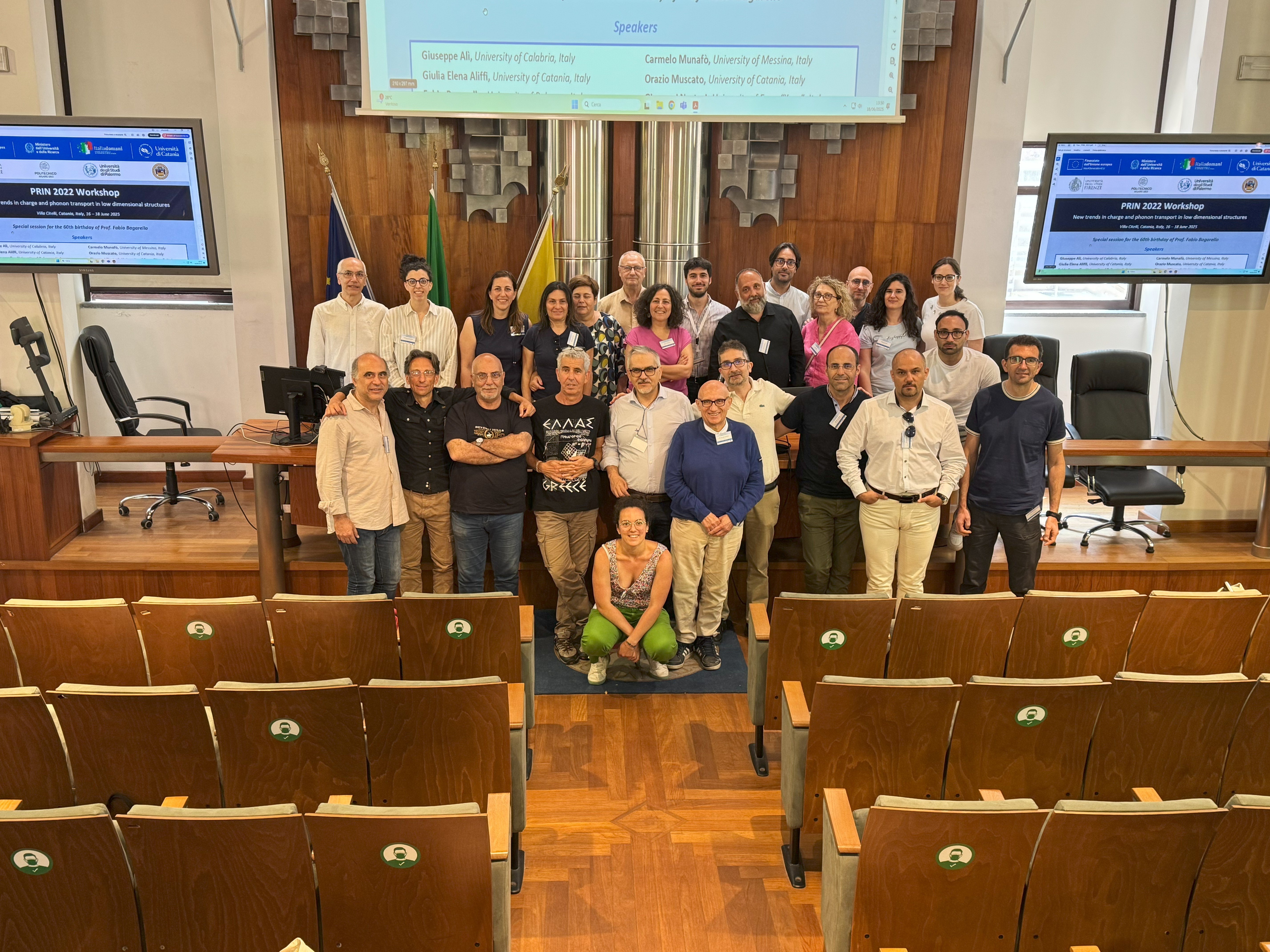New trends in charge and phonon transport in low dimensional structures
Villa Citelli, Catania, Italy, 16-18 June 2025
Special session for the 60th birthday of Prof. Fabio Bagarello
Scope
This workshop is related to the activities of the project PRIN 2022 provided by the Italian Ministry of University and Research. The network comprises five nodes: Università di Catania (UNICT), Politecnico di Milano (POLIMI), Università di Firenze (UNIFI), Università di Palermo (UNIPA), Università di Salerno (UNISA). The research activity is split into several work-packages (WP). The carrying out of the project will be performed by the units according to the objectives of the WPs. UNICT will be in charge of coordinating the activity of the whole network.
Title: Transport phonema in low dimensional structures: models, simulations and theoretical aspects
Abstract:
The project tackles relevant issues concerning the mathematical modeling and simulation of electrostatics and charge transport in
2D crystals, e.g. graphene and TM dichalcogenides, and structures such as nanoribbons and nanowires or polymeric nanofibers and
tubes, where the presence of confinement effects allows the formal description of the carrier flow as a two- or one-dimensional
electron gas. Due to the peculiar electrical and mechanical properties, graphene and TMD are considered very promising materials
for future electron devices and important components for composite functional materials. While for electron devices based on
standard semiconductor materials the efficiency of off-the-shelf commercial simulation tools is well established, the same does not
hold for the mentioned 2D materials. Besides, by increasing the miniaturization of devices, hot-spots are observed, that are zones
with very high crystal temperature due to the release of energy by highly energetic electrons. This makes thermal effects of primary
importance. Moreover, composite functional materials consisting of blends of different polymers or of a mix of polymeric
materials and nanoparticles made of graphene or other semi-conducting materials have also been recently considered for their
promising electrical and thermal properties (polymeric insulators including graphene nanoparticles and graphene-polymer
composites).
The main goals of the project are the following. The analytical properties of the Schrödinger equation in confined structures and
open systems will be investigated. Efficient stochastic Monte Carlo schemes for the Wigner equation will be developed including
collisions. Direct solutions of the semiclassical Boltzmann equations will be obtained by developing and employing advanced
numerical schemes based on the discontinuous Galerkin methods for studying the electron-electron interaction and the charge
transport in nanoribbons, nanowires and quantum dots. Similarly, phonon transport with coupling to the electron flow in graphene
will be tackled. Thermal effects will be introduced along with the piezoelectric ones and mechanical stresses. Macroscopic models
will be deduced from the transport equations by using the moment method and obtaining the needed closure relations by means of
the Maximum Entropy Principle. The obtained models will be used to simulate graphene field effect transistors. In order to allow
efficient simulations of nanocomposites, numerical methods for coupling models with different dimensionality will be developed,
focusing in particular on Finite Element/Embedded Interface to simulate interfaces with complex geometries that are not aligned to
the bulk mesh; upscaling techniques will be applied to evaluate macroscopic material properties from nanoscale modeling of
nanostructured materials. For disordered materials, effective macroscopic transport models and techniques to infer model
parameters from experimental data will be developed.
Duration: 24 months
Main ERC field: PE - Physical Sciences and Engineering
ERC subfields: PE1_12 Mathematical physics, PE1_19 Scientific computing and data processing, PE1_21 Application of mathematics in sciences
Project code: 2022TMW2PY
Program at a glance

Schematic Program

Book of Abstracts
Scientific Committee
- Vittorio Romano, University of Catania, Italy (chairman)
- Fabio Bagarello, University of Palermo, Italy
- Luigi Barletti, University of Florence, Italy
- Carlo De Falco, Polytechnic University of Milan, Italy
- Francesco Oliveri, University of Messina, Italy
- Vincenzo Tibullo, University of Salerno, Italy
Organizing Committee
- Vittorio Romano, University of Catania, Italy (chairman)
- Giulia Elena Aliffi, University of Catania, Italy
- Vito Dario Camiola, University of Catania, Italy
- Orazio Muscato, University of Catania, Italy
- Giovanni Nastasi, University of Enna "Kore", Italy
- Giulia Piccitto, University of Catania, Italy
- Rita Tracinà, University of Catania, Italy
Speakers
- Giuseppe Alì, University of Calabria, Italy
- Giulia Elena Aliffi, University of Catania, Italy
- Fabio Bagarello, University of Palermo, Italy
- Luigi Barletti, University of Florence, Italy
- Roberto Beneduci, University of Calabria, Italy
- Vito Dario Camiola, University of Catania, Italy
- Vito Antonio Cimmelli, University of Basilicata, Italy
- Michele Correggi, Polytechnic University of Milan, Italy
- Carlo De Falco, Polytechnic University of Milan, Italy
- Gregorio Falqui, University of Milano-Bicocca, Italy
- Francesco Gargano, University of Palermo, Italy
- Jean Pierre Gazeau, Paris Cité University, France
- Matteo Gorgone, University of Messina, Italy
- David Jou, Autonomous University of Barcelona, Spain
- Róbert Kovács, Budapest University of Technology and Economics, Hungary
- Sergiusz Kużel, AGH University of Krakow, Poland
- Giovanni Mascali, University of Calabria, Italy
- Omar Morandi, University of Florence, Italy
- Carmelo Munafò, University of Messina, Italy
- Orazio Muscato, University of Catania, Italy
- Giovanni Nastasi, University of Enna “Kore”, Italy
- Martina Pia Nunziata, University of Salerno, Italy
- Francesco Oliveri, University of Messina, Italy
- Giulia Piccitto, University of Catania, Italy
- Patrizia Rogolino, University of Messina, Italy
- Vittorio Romano, University of Catania, Italy
- Nella Rotundo, University of Florence, Italy
- Andrea Sacchetti, University of Modena and Reggio Emilia, Italy
- Lidia Saluto, University of Palermo, Italy
- Michele Sciacca, University of Palermo, Italy
- Antonio Sellitto, University of Salerno, Italy
- Alessandro Teta, Sapienza University of Rome, Italy
- Vincenzo Tibullo, University of Salerno, Italy
- Camillo Trapani, University of Palermo, Italy
- Raffaele Vitolo, University of Salento, Italy
Registration
The registration to the PRIN 2022 Workshop is free but mandatory.
The participants are invited to complete the online registration form at the following link.
https://forms.office.com/e/Vu4fpzfva4
The speakers should send the abstract of their talk by e-mail to Prof. Vittorio Romano (vittorio.romano@unict.it) by April 16, 2025.
The LaTeX template is available for the download here.
Venue
The University of Catania
The University of Catania, located in the historic city of Catania on the eastern coast of Sicily, Italy, stands as a prestigious institution with a rich academic tradition. Established in 1434, it is one of the oldest universities in Italy and has played a significant role in shaping the cultural and educational landscape of the region. The University offers a diverse range of undergraduate and postgraduate programs across various disciplines, including natural sciences, engineering, social sciences and humanities. With a strong emphasis on research and innovation, the University of Catania actively engages in cutting-edge projects and collaborations, both at the national and international levels. The campus itself reflects a blend of historical architecture and modern facilities, providing students with a stimulating learning environment.
The auditorium of Villa Citelli
The workshop will be held at the auditorium of Villa Citelli, located in the city center of Catania.
The address is Via Tomaselli, 31.
The Villa Citelli is a building in an eclectic architecture of Gothic-oriental taste. The building was built in 1904-1907 in an eclectic language (Eclecticism-Catanese liberty) in Gothic style by the architects Paolo Lanzerotti (1875-1944) and Salvatore Sciuto Patti (1877-1926). The building is now owned by the University of Catania and is home to the International Relations Operations Unit of the University of Catania.
Catania sights
Catania is a city located on the eastern coast of the island of Sicily in Italy. It is the second-largest city in Sicily, after Palermo. Catania is situated at the foot of Mount Etna, one of the most active volcanoes in the world, which has had a significant impact on the city's history.
The city has a rich historical and cultural heritage, with various architectural styles reflecting its diverse past. Catania has faced several natural disasters, including earthquakes and volcanic eruptions, but it has been rebuilt multiple times throughout its history.
Key landmarks in Catania include the Baroque-style Cathedral of Saint Agatha, the historic Elephant Fountain (Fontana dell'Elefante), and the Ursino Castle. The city is also known for its vibrant street markets, lively atmosphere, and delicious Sicilian cuisine. Catania serves as a gateway to exploring the surrounding natural attractions, such as Mount Etna and the beautiful Sicilian coastline.
Restaurants and bars
Sicilian cuisine is a rich and diverse blend of flavors, influenced by the various cultures that have inhabited the island over the centuries, including Greeks, Arabs, Normans, and Spanish.
Catania offers a wide range of dining experiences. In the map below you can find the areas where many restaurants and bars are present.
Don't forget to try the street food and the desserts prepared in the bars of the city center.
Information
Accommodation
A not exhaustive list of accommodations placed at a walking distance from the conference building can be found below.
How to reach Catania
By plane
The International Airport of Catania (CTA) is located 7 km from the city center. It is the main airport of the eastern coast of Sicily. There are airports in Comiso (CIY) 100 km, Palermo (PMO) 250 km, Trapani (TPS) 330 km. It is strongly recommended to land in Catania, if you plan to travel through another airport check carefully the connections to Catania.
By train
The main train station of the city is Catania Centrale. It is connected to the main cities of Sicily and also with long distance trains to the rest of Italy. The Catania Centrale station is also connected with local buses and the metro.
By bus
The main bus station of the city is located close to the train station of Catania Centrale. The main companies that connects Catania to the other main cities of Sicily are SAIS and Interbus.
How to reach the conference
From the Airport
From the International Airport of Catania it is possible to reach the city center by bus with the line Alibus. Check the time schedule on the AMTS website. The closest bus stop to the conference building is Viale.
From the train station
From the Catania Centrale train station it is possible to reach the conference building by local buses. Check the lines and the time schedule on the AMTS website. Another possibility is to take the metro at the stop Giovanni XXIII and get off at the stop Stesicoro. More information on the Circumetnea website.
Contacts
- Vittorio Romano, University of Catania, Italy (vittorio.romano@unict.it)














